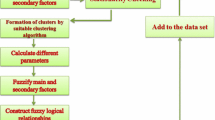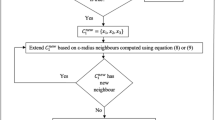Abstract
Gross Domestic Product (GDP) is a crucial indicator to evaluate national economic development of a nation and the status of the macro-economy of a country. In the present work, we have proposed a novel approach for predicting India’s nominal GDP. Six new variables have been considered to predict the GDP of India for which a hybridised model comprising of the Multivariate Fuzzy Time Series (MVFTS) model and the Monarch Butterfly Optimization (MBO) algorithm is used. MBO is used to determine the optimal length of intervals in the Universe of Discourse (UoD) while keeping the number of intervals constant. The accuracy of the resulting algorithm is determined by taking the measures, Mean Absolute Percentage Error (MAPE) and Root Mean Square Error (RMSE). The outcome obtained shows that the proposed MVFTS-MBO algorithm outperforms the existing methods for the prediction of India’s GDP.
















Similar content being viewed by others
Data availibility
Data was collected from https://www.ceicdata.com/en/indicator/india for different parameters and then combined together to form a dataset on which the research was carried out. In case of more details, the corresponding author can be contacted.
References
Indicators for India. https://www.ceicdata.com/en/indicator/india
Kisi O, Shiri J, Demir V (2017) Hydrological time series forecasting using three different heuristic regression techniques. In handbook of neural computation; Academic Press, pp 45-65. https://doi.org/10.1016/b978-0-12-811318-9.00003-x
Hunter JS (1986) The exponentially weighted moving average. J Qual Technol 18(4):203–210. https://doi.org/10.1080/00224065.1986.11979014
Holt CC (2004) Forecasting seasonals and trends by exponentially weighted moving averages. Int J Forecast 20(1):5–10. https://doi.org/10.1016/j.ijforecast.2003.09.0
Yuan C, Liu S, Fang Z (2016) Comparison of China’s primary energy consumption forecasting by using ARIMA (the autoregressive integrated moving average) model and GM (1, 1) model. Energy 100:384–390. https://doi.org/10.1016/j.energy.2016.02.001
Song Q, Chissom BS (1993) Forecasting enrollments with FTS Part I. Fuzzy Sets Syst 54(1):1–9. https://doi.org/10.1016/0165-0114(93)90355-l
Song Q, Chissom BS (1993) FTS and its models. Fuzzy Sets Syst 54(3):269–277. https://doi.org/10.1016/0165-0114(93)90372-o
Song Q, Chissom BS (1994) Forecasting enrollments with FTS-Part II. Fuzzy Sets Syst 62(1):1–8. https://doi.org/10.1016/0165-0114(94)90067-1
Chen SM (1996) Forecasting enrollments based on FTS. Fuzzy Sets Syst 81(3):311–319. https://doi.org/10.1016/0165-0114(95)00220-0
Liu HT, Wei ML (2010) An improved fuzzy forecasting method for seasonal time series. Expert Syst Appl 37(9):6310–6318. https://doi.org/10.1016/j.eswa.2010.02.090
Singh P, Borah B (2011) An efficient method for forecasting using FTS. In: Machine intelligence; Tezpur University, Assam , Narosa, India, pp. 67–75. https://doi.org/10.4018/978-1-5225-0914-1.ch013
Chen SM, Tanuwijaya K (2011) Multivariate fuzzy forecasting based on FTS and automatic clustering techniques. Expert Syst Appl 38(8):10594–10605. https://doi.org/10.1016/j.eswa.2011.02.098
Hwang JR, Chen SM, Lee CH (1998) Handling forecasting problems using FTS. Fuzzy Sets Syst 100(1–3):217–228. https://doi.org/10.1016/s0165-0114(97)00121-8
Sah M, Konstantin Y (2005) Forecasting enrollment model based on first-order FTS. World Acad Sci Eng Technol 1:375–378
Wong WK, Bai E, Chu AWC (2010) Adaptive time-variant models for fuzzy-time-series forecasting. IEEE Trans Syst Man Cybern Part B (Cybernetics) 40(6):1531–1542. https://doi.org/10.1109/tsmcb.2010.2042055
Bas E, Egrioglu E, Yolcu U et al (2019) Type 1 fuzzy function approach based on ridge regression for forecasting. Granul Comput 4:629–637. https://doi.org/10.1007/s41066-018-0115-4
Loia V, Tomasiello S, Vaccaro A, Gao J (2020) Using local learning with fuzzy transform: application to short term forecasting problems. Fuzzy Optim Decis Making 19(1):13–32. https://doi.org/10.1007/s10700-019-09311-x
Egrioglu E, Yolcu U, Bas E (2019) Intuitionistic high-order fuzzy time series forecasting method based on pi-sigma artificial neural networks trained by artificial bee colony. Granul Comput 4:639–654. https://doi.org/10.1007/s41066-018-00143-5
Bisht K, Kumar S (2019) Hesitant fuzzy set based computational method for financial time series forecasting. Granul Comput 4:655–669. https://doi.org/10.1007/s41066-018-00144-4
Chang J, Yu P (2019) Weighted-fuzzy-relations time series for forecasting information technology maintenance cost. Granul Comput 4:687–697. https://doi.org/10.1007/s41066-019-00157-7
Gupta KK, Kumar S (2019) Hesitant probabilistic fuzzy set based time series forecasting method. Granul Comput 4:739–758. https://doi.org/10.1007/s41066-018-0126-1
Gupta KK, Kumar S (2019) A novel high-order fuzzy time series forecasting method based on probabilistic fuzzy sets. Granul Comput 4:699–713. https://doi.org/10.1007/s41066-019-00168-4
Huarng KH, Yu THK, Hsu YW (2007) A multivariate heuristic model for fuzzy time-series forecasting. IEEE Trans Syst Man Cybern Part B (Cybernetics) 37(4):836–846. https://doi.org/10.1109/tsmcb.2006.890303
El Aziz MA, Hemdan AM, Ewees AA, Elhoseny M, Shehab A, Hassanien AE, Xiong S, Prediction of biochar yield using adaptive neuro-fuzzy inference system with particle swarm optimization. In: IEEE PES PowerAfrica; IEEE:2017, pp 115-120. https://doi.org/10.1109/powerafrica.2017.7991209
Chang JR, Wei LY, Cheng CH (2011) A hybrid ANFIS model based on AR and volatility for TAIEX forecasting. Appl Soft Comput 11(1):1388–1395. https://doi.org/10.1016/j.asoc.2010.04.010
Cheng CH, Wei LY, Liu JW, Chen TL (2013) OWA-based ANFIS model for TAIEX forecasting. Econ Model 30:442–448. https://doi.org/10.1016/j.econmod.2012.09.047
Wei LY (2013) A GA-weighted ANFIS model based on multiple stock market volatility causality for TAIEX forecasting. Appl Soft Comput 13(2):911–920. https://doi.org/10.1016/j.asoc.2012.08.048
Chen S, Chu H, Sheu T (2012) TAIEX forecasting using fuzzy time series and automatically generated weights of multiple factors. IEEE Trans Syst Man Cybern- Part A: Syst Humans 42(6):1485–1495. https://doi.org/10.1109/TSMCA.2012.2190399
Park JI, Lee DJ, Song CK, Chun MG (2010) TAIFEX and KOSPI 200 forecasting based on two-factors high-order FTS and particle swarm optimization. Expert Syst Appl 37(2):959–967. https://doi.org/10.1016/j.eswa.2009.05.081
Hsu LY, Horng SJ, Kao TW, Chen YH, Run RS, Chen RJ, Lai JL, Kuo IH (2010) Temperature prediction and TAIFEX forecasting based on fuzzy relationships and MTPSO techniques. Expert Syst Appl 37(4):2756–2770. https://doi.org/10.1016/j.eswa.2009.09.015
Kuo IH, Horng SJ, Chen YH, Run RS, Kao TW, Chen RJ, Lai JL, Lin TL (2010) Forecasting TAIFEX based on fuzzy time series and particle swarm optimization. Expert Syst Appl 37(2):1494–1502. https://doi.org/10.1016/j.eswa.2009.06.102
Singh P, Borah B (2014) Forecasting stock index price based on M-factors FTS and particle swarm optimization. Int J Approximate Reasoning 55(3):812–833. https://doi.org/10.1016/j.ijar.2013.09.014
Yang XS (2010) Nature-inspired metaheuristic algorithms. Luniver Press, UK
Kennedy J, Eberhart R (1995) Particle swarm optimization. In: Paper presented at the proceeding of the IEEE international conference on neural networks; Perth, Australia; 27 November-1 December 1995. https://doi.org/10.1109/icnn.1995.488968
Dorigo M, Maniezzo V, Colorni A (1996) Ant system: optimization by a colony of cooperating agents. IEEE Trans SystMan Cybern B Cybern 26(1):29–41. https://doi.org/10.1109/3477.484436
Goldberg DE (1989) Genetic algorithms in search, optimization, and machine learning. Addison-wesley, Reading, MA (NN Schraudolph and J, 3(1))
Gao XZ, Ovaska SJ (2002) Genetic algorithm training of Elman neural network in motor fault detection. Neural Comput Appl 11(1):37–44. https://doi.org/10.1007/s005210200014
Back T (1996) Evolutionary algorithms. In: Theory and practice: evolution strategies, evolutionary programming, genetic algorithms. Oxford University Press, Oxford , https://doi.org/10.1108/k.1998.27.8.979.4
Karaboga D, Basturk BA (2007) Powerful and efficient algorithm for numerical function optimization: artificial bee colony (ABC) algorithm. J Global Optim 39(3):459–471. https://doi.org/10.1007/s10898-007-9149-x
Li X, Yin M (2014) Self-adaptive constrained artificial bee colony for constrained numerical optimization. Neural Comput Appl 24(3–4):723–734. https://doi.org/10.1007/s00521-012-1285-7
Yang XS, Deb S (2009) Cuckoo search via Levy flflights. In: Abraham A, Carvalho A, Herrera F, Pai V (eds) Proceeding of world congress on nature & biologically inspired computing (NaBIC 2009); IEEE Publications, USA, pp 210–214 https://doi.org/10.1109/nabic.2009.5393690
Ouaarab A, Ahiod B, Yang X-S (2014) Discrete cuckoo search algorithm for the travelling salesman problem. Neural Comput Appl 24(7–8):1659–1669. https://doi.org/10.1007/s00521-013-1402-2
Yang X-S, Deb S (2013) Cuckoo search: recent advances and applications. Neural Comput Appl 24(1):169–174. https://doi.org/10.1007/s00521-013-1367-1
Li X, Wang J, Yin M (2014) Enhancing the performance of cuckoo search algorithm using orthogonal learning method. Neural Comput Appl 24(6):1233–1247. https://doi.org/10.1007/s00521-013-1354-6
Yang XS, Gandomi AH (2012) Bat algorithm: a novel approach for global engineering optimization. Engineering computations. https://doi.org/10.1108/02644401211235834
Mirjalili S, Mirjalili SM, Lewis A (2014) Grey wolf optimizer. Adv Eng Softw 69:46–61. https://doi.org/10.1016/j.advengsoft.2013.12.007
Mirjalili S (2015) The ant lion optimizer. Adv Eng Softw 83:80–98. https://doi.org/10.1016/j.advengsoft.2015.01.010
Storn R, Price K (1997) Differential evolution-a simple and efficient heuristic for global optimization over continuous spaces. J Global Optim 11(4):341–359. https://doi.org/10.1023/A:1008202821328
Wang G-G, Gandomi AH, Alavi AH, Hao G-S (2014) Hybrid krill herd algorithm with differential evolution for global numerical optimization. Neural Comput Appl 25(2):297–308. https://doi.org/10.1007/s00521-013-1485-9
Gould SJ (2002) In The structure of evolutionary theory. Harvard University Press, Cambridge. https://doi.org/10.1086/379461
Wang GG, Deb S, Cui Z (2019) Monarch butterfly optimization. Neural Comput Appl 31(7):1995–2014. https://doi.org/10.1007/s00521-015-1923-y
Jalali SMJ, Ahmadian S, Kebria PM, Khosravi A, Lim CP, Nahavandi S (2019) Evolving artificial neural networks using butterfly optimization algorithm for data classification. In: International conference on neural information processing. pp 596-607. Springer, Cham. https://doi.org/10.1007/978-3-030-36708-4_49
Shah M (2007) FTS: A realistic method to forecast Gross domestic capital of India. Anal Des Intell Syst Soft Comput Tech. https://doi.org/10.1007/978-3-540-72432-2_26
Junoh MZHM (2004) Predicting GDP growth in Malaysia using knowledge-based economy indicators: a comparison between neural network and econometric approaches. Sunway Acad J 1:39–50
Bo LIU, Li WG, Wang XT, Jin HL, Chen XY, Li XT, Liu YH (2016) The prediction of secondary exponential smoothing of the total GDP of Mongolia. In: DEStech transactions on economics, business and management, (iceme-ebm). https://doi.org/10.12783/dtem/iceme-ebm2016/4128
Kumar S, Muhuri PK (2019) A novel GDP prediction technique based on transfer learning using CO2 emission dataset. Appl Energy 253:113476. https://doi.org/10.1016/j.apenergy.2019.113476
Rajesh P, Karthikeyan M (2019) Data Assimilation of Gross Domestic Product (GDP) in India Using Stochastic Data Mining Approach. J Comput Theor Nanosci 16(4):1478–1484. https://doi.org/10.1166/jctn.2019.8061
Sokolov-Mladenović S, Milovančević M, Mladenović I, Alizamir M (2016) Economic growth forecasting by artificial neural network with extreme learning machine based on trade, import and export parameters. Comput Hum Behav 65:43–45. https://doi.org/10.1016/j.chb.2016.08.014
Ghomsheh VS, Shoorehdeli MA, Teshnehlab M (2007) Training ANFIS structure with modified PSO algorithm. In: Mediterranean conference on control automation; IEEE, pp 1-6. https://doi.org/10.1109/med.2007.4433927
Ahmadian S, Khanteymoori AR (2015) Training back propagation neural networks using asexual reproduction optimization In: 7th conference on information and knowledge technology (IKT) 2015, Urmia, pp 1-6. https://doi.org/10.1109/IKT.2015.7288738
Ghanbari A, Kazemi SM, Mehmanpazir F, Nakhostin MM (2013) A cooperative ant colony optimization-genetic algorithm approach for construction of energy demand forecasting knowledge-based expert systems. Knowl-Based Syst 39:194–206. https://doi.org/10.1016/j.knosys.2012.10.017
Mandal P, Haque AU, Meng J, Srivastava AK, Martinez R (2012) A novel hybrid approach using wavelet, firefly algorithm, and fuzzy ARTMAP for day-ahead electricity price forecasting. IEEE Trans Power Syst 28(2):1041–1051. https://doi.org/10.1109/tpwrs.2012.2222452
Bragoli D, Fosten J (2018) Nowcasting indian gdp. Oxford Bull Econ Stat 80(2):259–282. https://doi.org/10.1111/obes.12219
Karaçuha E, Tabatadze V, Karacuha K, Önal NÖ, Ergün E (2020) Deep assessment methodology using fractional calculus on mathematical modeling and prediction of gross domestic product per capita of countries. Mathematics 8(4):633. https://doi.org/10.3390/math8040633
Zadeh LA (1965) Fuzzy Sets. Inform Control 8:338–353. https://doi.org/10.1016/S0019-9958(65)90241-X
Zadeh LA (1973) The concept of Linguistic variable and its application to approximate reasoning; memorandum ERL-M, 411, Berkeley
Monarch butterfly. https://en.wikipedia.org/wiki/Monarch_butterfly
Kamaruzaman AF, Zain AM, Yusuf SM, Udin A (2013) Levy flight algorithm for optimization problems-a literature review. In: Applied mechanics and materials. Vol. 421, pp. 496-501; Trans Tech Publications Ltd: https://doi.org/10.4028/www.scientific.net/amm.421.496
Lee LW, Wang LH, Chen SM, Leu YH (2006) Handling forecasting problems based on two-factors high-order FTS. IEEE Trans Fuzzy Syst 14(3):468–477. https://doi.org/10.1109/tfuzz.2006.876367
Liang Y, Leung KS (2011) Genetic Algorithm with adaptive elitist-population strategies for multimodal function optimization. Appl Soft Comput 11(2):2017–2034. https://doi.org/10.1016/j.asoc.2010.06.017
Du H, Wang Z, Zhan WEI, Guo J (2018) Elitism and distance strategy for selection of evolutionary algorithms. IEEE Access 6:44531–44541. https://doi.org/10.1109/access.2018.2861760
Huarng K (2001) Effective lengths of intervals to improve forecasting in FTS. Fuzzy Sets Syst 123(3):387–394. https://doi.org/10.1016/s0165-0114(00)00057-9
Funding
There was no funding for this work.
Author information
Authors and Affiliations
Corresponding author
Ethics declarations
Conflicts interests
The authors declare that they have no conflict of interest.
Additional information
Publisher's Note
Springer Nature remains neutral with regard to jurisdictional claims in published maps and institutional affiliations.
Rights and permissions
About this article
Cite this article
Jha, V.V., Jajoo, K.S., Tripathy, B.K. et al. An improved monarch butterfly optimization based multivariate fuzzy time series approach for forecasting GDP of India. Evol. Intel. 16, 605–619 (2023). https://doi.org/10.1007/s12065-021-00686-8
Received:
Revised:
Accepted:
Published:
Issue Date:
DOI: https://doi.org/10.1007/s12065-021-00686-8




